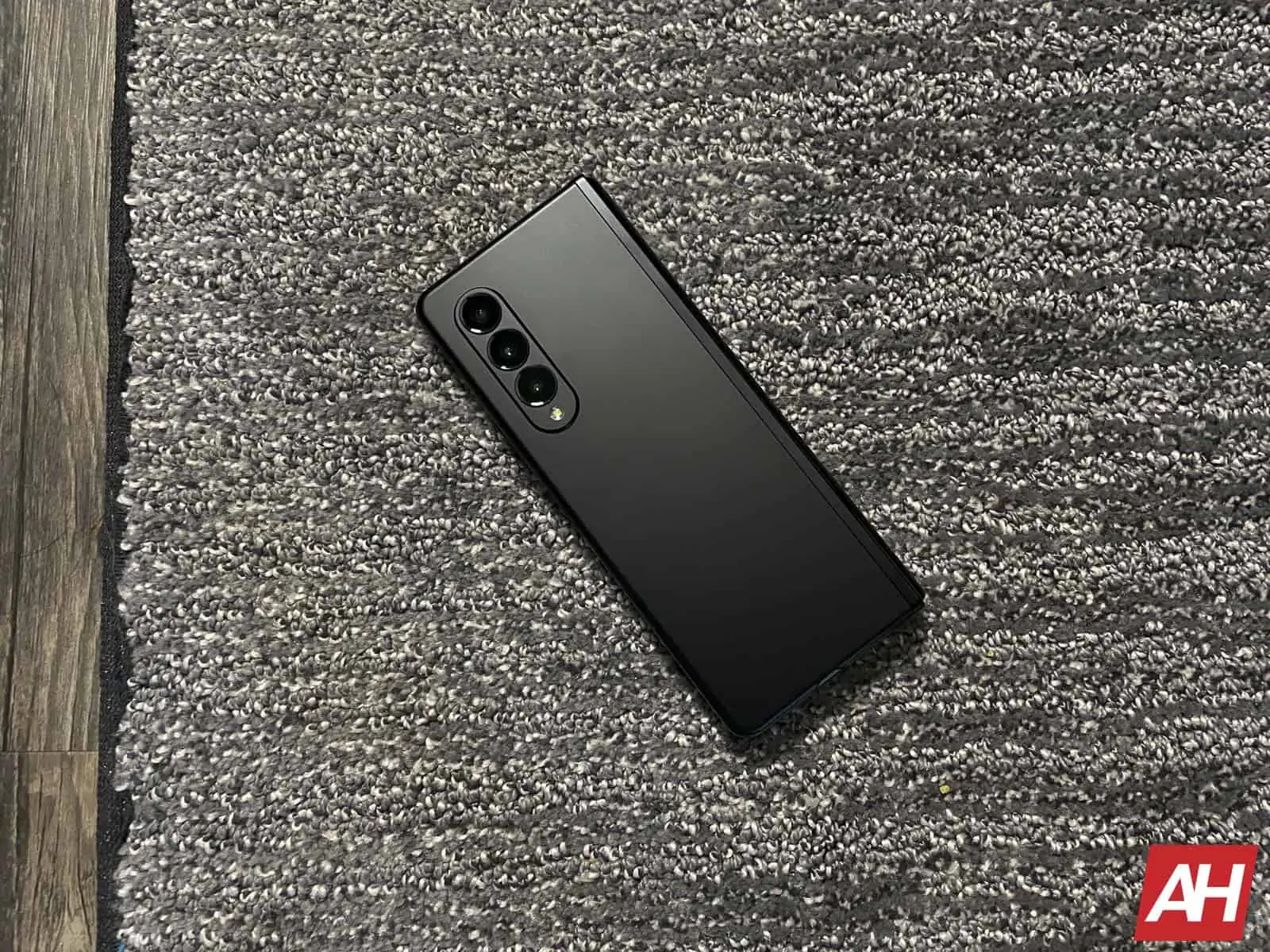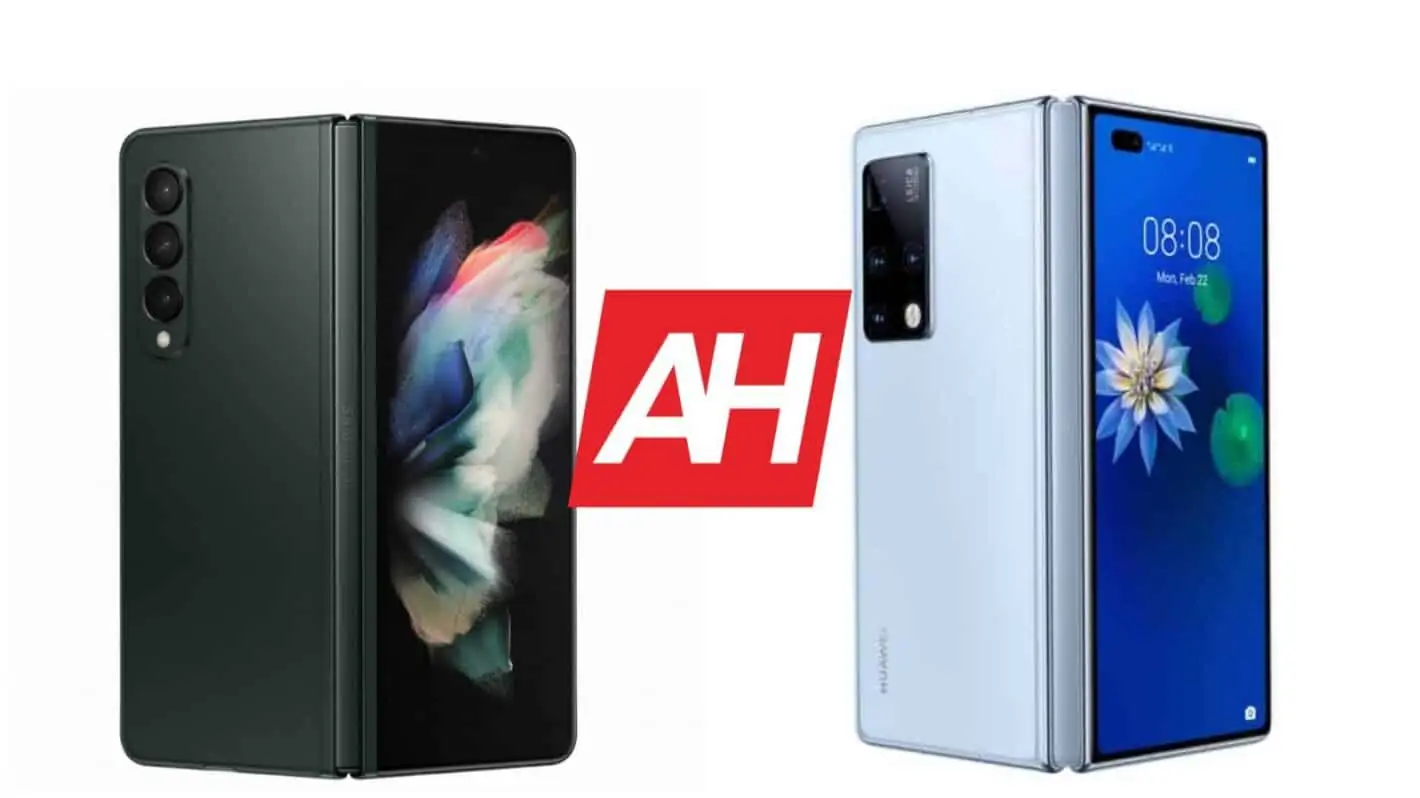In this article, we’ll compare two rather compelling foldables, the Samsung Galaxy Z Fold 3 vs Huawei Mate X2. These are the best foldables Samsung and Huawei have to offer, respectively. Truth be said, the Mate X2’s availability is nowhere near the availability of the Z Fold 3, and the Huawei ban issued by the US has a lot to do with that. Either way, comparing these two devices certainly is worth it.
They actually follow a similar design language. Huawei got inspired by Samsung in that regard, as the Mate X2 is considerably different from its predecessor. It opens up like a book, and it does offer really compelling hardware overall. The Galaxy Z Fold 3 is essentially a refinement of the Z Fold 2 recipe, and that’s not a bad thing, not at all. Let’s kick off the Samsung Galaxy Z Fold 3 vs Huawei Mate X2 comparison, shall we.
Specs
| Samsung Galaxy Z Fold 3 | Huawei Mate X2 | |
| Screen size | Main: 7.6-inch fullHD+ Dynamic AMOLED 2X Flex display (foldable, 120Hz) Secondary (Cover): 6.2-inch HD+ Super AMOLED display (flat, 120Hz) |
Main: 8-inch fullHD+ OLED display (foldable, 90Hz) Secondary (Cover): 6.45-inch OLED display (flat, 60Hz) |
| Screen resolution | Main: 2208 x 1768 Secondary (Cover): 2268 x 832 |
Main: 2480 x 2200 Secondary (Cover): 2700 x 1160 |
| SoC | Qualcomm Snapdragon 888 | Huawei HiSilicon Kirin 9000 |
| RAM | 12GB (LPDDR5) | 8GB |
| Storage | 256GB/512GB; non-expandable | 256GB/512GB (UFS 3.0); expandable up to 256GB |
| Rear cameras | 12MP (1.8um pixel size, Super Speed Dual Pixel OIS, f/1.8 aperture, 83-degree FoV) 12MP (1.0um pixel size, f/2.4 aperture, 45-degree view, 2x optical zoom, 10x digital zoom, telephoto) 12MP (1.12um pixel size, f/2.2 aperture, 123-degree FoV, ultra-wide) |
50MP (f/1.9 aperture, 1.22um pixel size, omnidirectional PDAF, Laser AF, OIS) 12MP (telephoto, f/2.4 aperture, PDAF, OIS, 3x optical zoom) 16MP (ultra-wide, f/2.2 aperture, 17mm lens) 8MP (periscope telephoto, f/4.4 aperture, PDAF, OIS, 10x optical zoom) |
| Front cameras | Main: 4MP (f/1.8 aperture, 2.0um pixel size, 80-degree FoV) Secondary: 10MP (f/2.2 aperture, 1.22um pixel size, 80-degree FoV) |
16MP (f/2.2 aperture) |
| Battery | 4,500mAh, non-removable, 25W fast wired charging, 11W wireless charging, 4.5W Wireless PowerShare | 4,5o0mAh, non-removable, 55W wired charging |
| Dimensions | Unfolded: 158.2 x 128.1 x 6.4mm Folded: 158.2 x 67.1 x 16.0mm |
Unfolded: 161.8 x 145.8 x 8.2mm Folded: 161.8 x 74.6 x 14.7mm |
| Weight | 271 grams | 295 grams |
| Connectivity | 5G, LTE, NFC, Bluetooth 5.0, Wi-Fi, USB Type-C | 5G, LTE, NFC, Bluetooth 5.2, Wi-Fi, USB Type-C |
| Security | Side-facing fingerprint scanner | Side-facing fingerprint scanner |
| OS | Android 11 One UI 2.5 |
Android 10 EMUI 11 |
| Price | $1,799 | $2,785 |
| Buy | Samsung | Huawei |
Samsung Galaxy Z Fold 3 vs Huawei Mate X2: Design
Both devices are made out of metal and glass. They feature a frame made out of metal, and a glass backplate. Both devices also come with two displays, and both open up like a book. The Huawei Mate X2 is taller, wider, and thicker than the Z Fold 3. That goes for both its folded and unfolded states. It is also heavier than the Z Fold 3, though truth be said they’re both quite heavy, and the difference is not that big in that regard.
Also, the Huawei Mate X2 does have larger displays than its competitor, so that directly affects its size and weight. Both devices are quite difficult to use with one hand, even when they’re folded. The Z Fold 3 is somewhat easier to use in such a state, though, as it’s narrower and slightly lighter. Still, your pinky finger will complain, as you will feel fatigue soon, if you end up holding either device with one hand.

The Huawei Mate X2 has a pill-shaped display cutout on its second display, but not on its main one. That does differ from the Z Fold 3, which has a single camera hole on its secondary display, and an under-display camera on its main one. We’ll talk more about that in the next section, though. The two devices have different-looking camera islands on the back, but they’re placed in the same spot.
Samsung Galaxy Z Fold 3 vs Huawei Mate X2: Display
As mentioned in the intro, both devices have two displays, and one of those two panels is foldable on both phones. The Samsung Galaxy Z Fold 3 includes a 7.6-inch 2208 x 1768 Dynamic AMOLED 2X display. That is a foldable display, which is flat, and which offers a 120Hz refresh rate. There is a UTG layer on top of that display, and it does support HDR10+ content. That panel can hit 1,200 nits of peak brightness. A secondary panel on the device is a 6.2-inch 2268 x 832 Dynamic AMOLED 2X display which also offers a 120Hz refresh rate. That panel is protected by the Gorilla Glass Victus, and it’s flat. Both the main and secondary displays have display camera holes, one on each.
The Huawei Mate X2, on the other hand, has an 8-inch 2480 x 2200 foldable OLED display. That is a 90Hz panel, and it’s flat. A 6.45-inch display is also included here, as the phone’s secondary panel. We’re looking at a 2700 x 1160 resolution here. That display also offers a 90Hz refresh rate, by the way. The main display on the phone does not have a display camera hole, while the secondary one has a pill-shaped one.
The Huawei Mate X2’s panel feels a bit more plasticky under the fingers than the Z Fold 3’s. It’s more similar to the original Galaxy Fold and Z Fold 2, than it is to the Z Fold 3. The Galaxy Z Fold 3’s displays also do get a bit brighter, and they do look better on paper. Both sets of displays are good, though, far from it, and sharp enough. They’re vivid, and have good viewing angles.
Samsung Galaxy Z Fold 3 vs Huawei Mate X2: Performance
You’d expect excellent performance on both of these phones, considering they’re flagship-grade, and cost a pretty penny, right? Well, yes, and that’s exactly what you’d get. We’re at a point where all major OEMs release flagships which offer beastly performance. They use high-end hardware, and do well when it comes to optimizations with the software. Well, both of these companies did that, even though the software is vastly different.
One important thing to note, on the software side of things, is that the Mate X2 does not support Google services. That is due to the US ban, so if you’re a Google user, the Mate X2 is not the phone you should consider. When it comes to the UI look in general, the two phones are considerably different, but both do feel very much like Android, and will feel familiar if you’ve used an Android phone or tablet before.
The Galaxy Z Fold 3 combines the Snapdragon 888 SoC with 8GB or 12GB of LPDDR5 RAM. You can get the phone in 256GB or 512GB storage models, and we’re looking at UFS 3.1 flash storage here. The Mate X2, on the other hand, is fueled by the Kirin 9000 5G, Huawei’s very own flagship processor. That chip is combined with 8GB of RAM and 256GB or 512GB of storage. We still don’t know if it’s UFS 3.0 or 3.1 storage, but regardless, the phone is extremely fast. Gaming should be no problem for either device.
Samsung Galaxy Z Fold 3 vs Huawei Mate X2: Battery
The Galaxy Z Fold 3 includes a 4,400mAh battery. The Z Fold 3, on the other hand, comes with a 4,500mAh battery pack. Is that enough to keep the phones going long enough? Well, the battery life could be better on both phones. It will depend on how much you use the main display, though. If you rely on the outer display more, you will drain less battery juice. To be honest, though, most of you will probably rely on that main display more.
The Huawei Mate X2 does offer better battery life than the Z Fold 3. We can’t really speak of numbers here, as your usage will reflect directly on it, in a huge way, as there are two displays here, there are simply too many factors here. From our experience, though, the Z Fold 3 provides around 5 hours of screen-on time, even less at times. It can go well below that if you really push it hard, and use that main display all the time. It offers a somewhat worse battery life than its predecessor. The Mate X2 should be able to do a bit better than that, maybe even an hour of screen-on-time better, but that will depend on the situation.
Considering that the battery life is not amazing on either phone, you’re probably wondering how fast you can charge them. The Mate X2 does offer faster charging, but only wired. The Galaxy Z Fold 3 offers 25W wired charging, 11W wireless charging, and 4.5W reverse wireless charging. The Mate X2 supports 55W wired charging, and no wireless or reverse (wireless) charging. The Galaxy Z Fold 3 does not come with a charger in the box, but the Mate X2 does.
Samsung Galaxy Z Fold 3 vs Huawei Mate X2: Cameras
Both the Galaxy Z Fold 3 and Mate X2 have compelling camera setups on paper. They are considerably different, though. The Z Fold 3 includes three 12-megapixel cameras on the back, in addition to a 10-megapixel selfie camera, and a 4-megapixel under-display selfie camera. The Mate X2 sports 50, 12, 8, and 16-megapixel units on the back, and a single 16-megapixel front-facing camera.

The camera performance on both phones is really good. They can capture really detailed, colorful, and well-balanced images during the day. The dynamic range on both is really good, as is HDR performance. When the light goes away, they still manage to capture really good shots, and they’re quite consistent at it as well. Both phones have telephoto and ultrawide cameras, but the Mate X2 does have an advantage thanks to its periscope camera. You can achieve some crazy zoom levels with that camera, and achieve great results, as long as you don’t use it in low light.
Both telephoto and ultrawide cameras do a great job on both phones. A 10-megapixel selfie camera on the Galaxy Z Fold 3, and a 16-megapixel one on the Mate X2 are good enough. They do the job in both video and image departments really well. That 4-megapixel under-display camera on the Z Fold 3, well, that one is not all that good. It produces washed-out images, and you should use it for video calls only.
Audio
Both of these phones feature stereo speakers, and those speakers are really good on both. The ones on the Galaxy Z Fold 3 do look better on paper, and they do sound a bit sharper, but not by much. Those speakers are tuned by AKG, by the way, as you’d expect. You can tune up the volume quite a bit, and the sound won’t distort on either phone. The vocals are sharp enough, and you’ll even get some bass.
Neither of the two phones has a 3.5mm headphone jack. You’ll have to rely on a dongle, Type-C headphones, or a Bluetooth connection. Luckily, both phones do support Bluetooth 5.2, as you’d expect. If you do use a quality set of headphones, the sound these two phones provide can be quite good, just don’t expect miracles.

